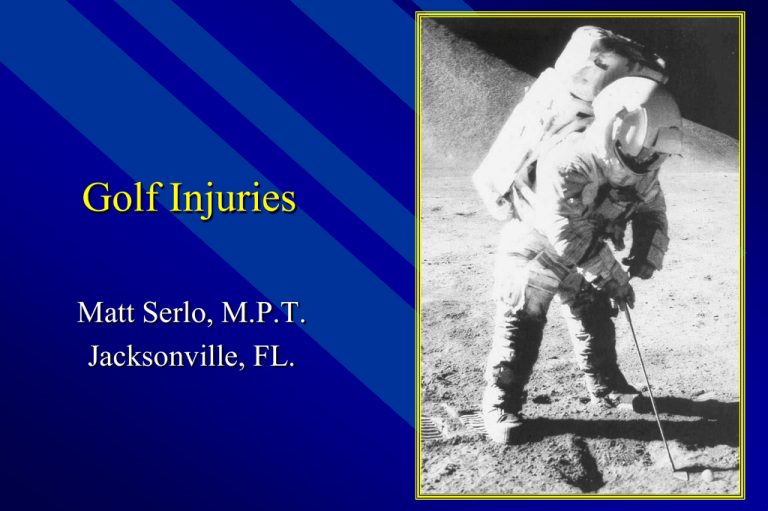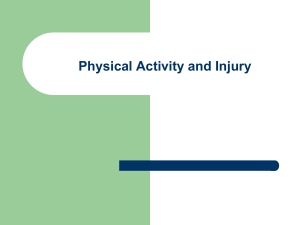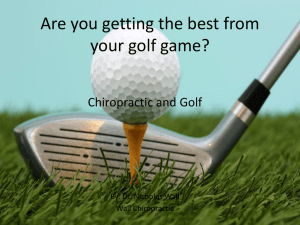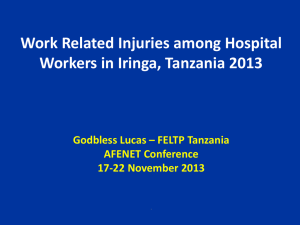Golf Injuries - Five Star Physical Therapy
advertisement

Golf Injuries Matt Serlo, M.P.T. Jacksonville, FL. The Typical Golfer Competitive in nature Active and fitness-minded individuals Swings too hard Perceives golf as a passive sport Eager to improve Causes of Injuries Limited Flexibility Decreased Strength Poor Posture Balance Inappropriate Warm-up Inconsistent Swing Swings Too Hard!! Anatomy of Golf – Shoulder Gleno-humeral Joint Primary movers (pec, delt, lats) Stabilizers / RTC mm’s Motions include; Flexion – Extension ABDuction – ADDuction Horizontal ABD – ADD External – Internal Rotation Circumduction Most Common Golfing Injuries Shoulder Rotator Cuff Tendinitis irritation/ inflammation of the rotator cuff tendons in shoulder Rotator Cuff Strain/Tear muscle or tendon in shoulder Shoulder Injuries:Factors Lack of ROM/flexibility - External rotation, horizontal adduction Thoracic posture Strength of Rotator Cuff Arthritic conditions Joint integrity hypo/hypermobility Shoulder Motion Hor Add: 130 degrees (lead) ER: 100 degrees (back) Causes if limited -Steep swing -Elbow breakdown -Lateral slide -Improper grip Anatomy of Golf – Forearm Ulna & Radius Flexor mm group Extensor mm group Deviators Motions include; Wrist-Finger Flexion – Extension Forearm Pronation – Supination Radial – Ulnar Deviation Most Common Golfing Injuries Hand / Wrist DeQuervain’s Syndrome tendinitis of the thumb extensors Hook of Hamate Fractures - small wrist bone on palmer side Ligament sprains Muscle/Tendon strains Wrist and Hand Injuries Lack of Range of Motion - Thumb extension or radial deviation Inappropriate grip - too much or too little Trauma - hitting the ground Wrist Motion Back wrist extension: 70 degrees Front wrist radial deviation: 20 degrees Front thumb extension: 50 degrees If restricted: -unable to hold angle-club speed -square clubface Most Common Golfing Injuries Elbow Lateral Elbow - tendinitis strain to lead arm at wrist extensor muscles Medial Elbow - stretch/sprain of back arm inside ligaments Elbow injuries Improper grip - unnatural grip not allowing hands to move properly will cause stress at both wrist and elbow Valgus Stress-trauma/repetition Supination/Pronation Anatomy of Golf – Thigh Femur and Patella Quads, HS, ADD, ABD Motions include; Flexion – Extension ABD – ADD Patellar Alignment Most Common Golfing Injuries Knee Ligament damage - lead knee twist on follow-through with poor balance Cartilage damage - rotation & extension during follow-through Tendonitis: I.T. band Knee Injuries:Causes Lack of range of motion Lack of stability in the knee -ACL (lead) -LCL (back) Quad strengthstatic/dynamic Proprioception Improper swing mechanics Anatomy of Golf – Lower Leg Tibia, Fibula, Talus, Calcaneus, etc. Posterior mm’s (gastroc-soleus) Ant/Lateral mm’s (Ant Tib/Peroneal) Motions include; Flexion – Extension Inversion – Eversion Supination - Pronation Ankle Ligament damage - Lead ankle twist on follow through Inflammation: Plantar Fascitis, Achilles Tendonitis Ankle Injuries:Causes Lack of ROM/flexibility Improper swing mechanics Pronated or supinated feet Improper shoe wear Proprioception Anatomy of Golf – Cervical Spine Seven Cervical Vertebrea Spinal muscles Motions Include; Flexion Extension Side Bend (L&R) Rotation (L&R) Cervical Injuries:Causes Lack of sufficient ROM Trauma caused by improper swing mechanics Eye Dominance Cervical Motion Optimal: 90 degrees If restricted: -Drop left shoulder -lateral tilt of head-lose of spinal angle -lateral shift of hips Anatomy of Golf – Hip SI, Ilium, Femur Anterior mm’s Posterior mm’s Lateral mm’s & connective tissue Motions include; Flexion – Extension ABDuction – ADDuction External – Internal Rotation Circumduction Most Common Golfing Injuries Hip Inflammation: Bursitis, Tendonitis-Lead leg. DJD. Hip Injuries: Factors Lack of ROM/Flexibility Decreased Strength -rotators, abductors Poor Balance Poor Posture Anatomy of Golf – Trunk Thoracic & Lumbar Spine, Ribs Anterior – Abdominals (3) Posterior – Paraspinals – Rotatory Motions include; Flexion – Extension Side Bending (L&R) Rotation (L&R) Most Common Golfing Injuries Back Muscular strains/spasms - erector spinae muscle group Ligament sprains Vertebral disc damage/displacement -Herniated disc - disc protrudes out from back -Ruptured disc - disc nucleus ruptures Back Injuries Improper Address position (not in neutral spine) Lack of ROM or flexibility Abdominal Integrity Proprioception Medical history Spine Angles Primary: 40-45 degrees Secondary: 8-12 degrees Benefits of maintaining angles during swing: -minimize lateral movement -maintain correct swing path -maintain balance: COG within BOS -decreased stress on the body Thank You









